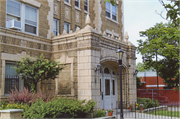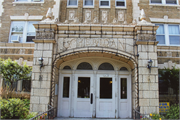Property Record
2435 W WISCONSIN AVE
Architecture and History Inventory
| Historic Name: | Sheridan Apartment Building |
|---|---|
| Other Name: | |
| Contributing: | |
| Reference Number: | 113887 |
| Location (Address): | 2435 W WISCONSIN AVE |
|---|---|
| County: | Milwaukee |
| City: | Milwaukee |
| Township/Village: | |
| Unincorporated Community: | |
| Town: | |
| Range: | |
| Direction: | |
| Section: | |
| Quarter Section: | |
| Quarter/Quarter Section: |
| Year Built: | 1927 |
|---|---|
| Additions: | |
| Survey Date: | 19832014 |
| Historic Use: | apartment/condominium |
| Architectural Style: | Spanish/Mediterranean Styles |
| Structural System: | |
| Wall Material: | Brick |
| Architect: | Backes & Uthus |
| Other Buildings On Site: | |
| Demolished?: | No |
| Demolished Date: |
| National/State Register Listing Name: | Sheridan Apartment Building |
|---|---|
| National Register Listing Date: | 12/14/2020 |
| State Register Listing Date: | 8/14/2020 |
| National Register Multiple Property Name: |
| Additional Information: | A 'site file' exists for this property. It contains additional information such as correspondence, newspaper clippings, or historical information. It is a public record and may be viewed in person at the Wisconsin Historical Society, State Historic Preservation Office. This structure is an excellent example of 1920s apartment buildings. Its highly decorated facade is influenced by Neo-Classical elements. 2015- "The Sheridan is located at 2435 W. Wisconsin Avenue. The rectangular six-story building is located on the south side of the street and occupies the majority of the long, narrow lot. It is separated from W. Wisconsin Avenue by a concrete terrace with a single mature tree, concrete sidewalk, and a shallow grassy lawn with two modern light posts. The building is accessed by a wide concrete walk flanked by wrought-iron hand rails. A paved area located between the building and the west property line, which is demarcated by a chain-link privacy fence, provides service access to the building. This area is restricted by a modern gate. The east property line is also demarcated by a chain-link fence, which separates the building from a surface parking lot associated with the adjacent Eagles Ballroom. A small grassy lawn is located at the rear of the building and a pipe railing set on a concrete foundation separates the building from the residences fronting W. Michigan Street at the rear. Designed by the Milwaukee firm Backes & Uthes in the Mediterranean Revival style, the building was constructed in 1927 and includes 55 studio and one-bedroom apartments. It is clad in variegated brown brick with elaborate terra cotta ornamentation. The flat roof features terra cotta coping along the parapet and a large interior brick chimney. A small hip-roof tower associated with the penthouse projects from the center of the roof. It has copper roof cladding and elaborate terra cotta ornamentation, and is very similar to details included on the facade. Windows are a combination of the original three-over-one and replacement, one-over-one, double-hung sash. A wide belt course comprised of a terra cotta stringcourses and a brick soldier course with intermittent floral terra cotta panels encircles the front (north) facade and side (east and west) elevations. The front facade is three bays wide and the outer two bays project slightly. The center bay includes the elaborate terra cotta entrance and a series of four evenly spaced windows on each story, with terra cotta sills. Decorative terra cotta tiles placed in brick header course panels are located beneath each window (with the exception of the first story). A wide terra cotta cornice with four circular motifs stretches across this bay and is capped by a copper drip cap. The outer bays have a tower-like appearance and are capped with hip roofs clad in copper with decorative copper cresting. Both have terra cotta quoins on either side and feature pairs of windows on each story, with terra cotta sills and keystone lintels. Sixth story windows have an arched lintel with a keystone and an elaborate terra cotta surround that consists of a projecting balustrade with a central rosette detail and twisted spiral pilasters that support an ogee arch. Terra cotta rosettes flank the arch at the cornice level. The central entrance is included in a one-story vestibule that projects from the center of the facade. The north-facing portion of the vestibule is clad in terra cotta and features corner pilasters with floral panels at the capitals and terra cotta finials and cresting along the parapet. The recessed entrance is comprised of two original, wood-panel, single-light doors flanked by narrow, fixed, wood panels with single lights and separated by decorative turned columns. A series of four arched lead-glass headers with floral designs extends across the doors and elaborate floral carvings are located in the spandrels. The lamps flanking the entrance are modern replacements that are similar in appearance to the original bronze lamps featured on the plan sheets. "Sheridan" is incised into the terra cotta above the doors. Both side (east and west) elevations of the vestibule feature a brick panel with a terra cotta surround similar to the window surrounds on the facade; this is consistent with the original plans. The vestibule is flanked by modular concrete block planters that were added c.2005. The side (east) elevation features five bays. The outer two bays project slightly from the building. The northernmost bay is the side of the projecting facade tower and features similar terra cotta details, including quoins, paired windows with keystone lintels, and rosettes. The southernmost bay features paired windows with terra cotta sills and terra cotta coping and rosettes near the roofline. The center bay has pilasters on either side that are capped by terra cotta finials. The cornice is capped by terra cotta coping and features four evenly spaced rosettes. The remaining two bays lack ornamentation, with the exception of the terra cotta cornice and belt course. Windows are singles and grouped in pairs and threes. The other side (west) elevation is identical, with the exception of three evenly spaced first-story entrances with the original wood panel doors and copper awnings. Two of the entrances access interior stairwells. The third entrance accesses the lower level. The rear (south) elevation is clad in variegated brown brick and features minimal ornamentation. Like the facade, it is three bays wide and the outer two bays project slightly. Windows are paired with terra cotta sills and terra cotta coping is located at the parapet. A single wood panel door is centrally located at the basement level, which is partially exposed due to a slight slope at the rear of the lot. This entrance accesses a space that historically served as a laundry room. Interior The front entrance accesses an inner vestibule that features textured plaster walls and crown molding with a floral motif. A wood door with a large fixed light flanked by fixed wood panels with sidelights accesses the lobby area. Like the vestibule, the lobby has textured plaster walls and crown molding and the walls features decorative panels with modern sconces. A series of three steps with wrought iron railings accesses the center hallway through an arched entryway. The lobby retains the original tile floor and mopboards, although a portion of tile was previously covered and the surface was subsequently damaged. The hallway also features textured plaster and crown molding. The west side of the hallway includes two interior staircases and the elevator shaft. Apartment units retain the original wood entry doors. Each apartment also features a small metal door within the wall that was used for parcel delivery. Access to individual apartment units was not permitted; however, the property manager stated that the units retain their original configuration and several details, including woodwork, built-ins, and fixtures. According to the building plans, the basement included a single apartment (likely for the janitor), two laundry rooms, a trunk room, meter room, fuel room, boiler room, and two storage rooms (see the enclosed floorplans). The upper stories included 13 studio and 42 one-bedroom units with varying configurations. Each unit included a kitchenette, dinette, living room, and bathroom. Although plans indicate a penthouse, details for the space are not included in available building plans. The projecting tower on the roof, referred to as the penthouse, may have been a space open to all residents rather than a private space associated with a single apartment unit." -"Sheridan Apartment Building", WisDOT #2190-00-00, Prepared by Mead & Hunt, Inc. (2015). 201- "The Sheridan Apartment building is a six-story, Mediterranean Revival style building constructed in 1926 and designed by Backes & Uthus. It has a rectangular plan, is clad in brick and terra cotta, and has a flat roof. The two outer bays of the building are slightly taller than the main roof, and have hip roofs clad in copper. Terra cotta quoins are located on the corners of the facade. The main entrance is located within a one-story projection that is centered on the (north) facade. It has a flat roof that has floral and scallop ornamentation. The original double wooden door with simple sidelights and a floral fanlight is intact. Windows on the central portion of the facade, and at the cornice are three-over-one, double-hung, wood sash wood with simple sills. Terra cotta tiles are between each floor. The two outer bays have centered, paired windows that are also three-over-one, double-hung, wood sash. They have simple sills and lintels with a prominent keystone. Windows at the sixth story have a twisted spiral column and a short balustrade." -"W Wisconsin Ave, 20th St-35th St", WisDOT #2190-00-00, Prepared by Mead & Hunt, Inc. (2014). |
|---|---|
| Bibliographic References: | Sanborn Maps 1910-1961. Permit. Ad for formal opening, Milwaukee Sentinel, 22 May 1927, Section 7, 2B. includes drawing. |
| Wisconsin Architecture and History Inventory, State Historic Preservation Office, Wisconsin Historical Society, Madison, Wisconsin |





